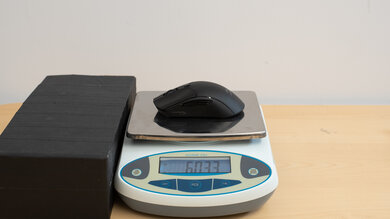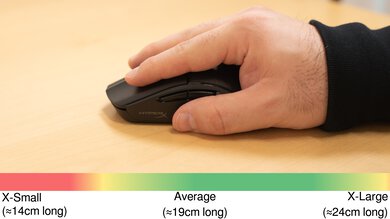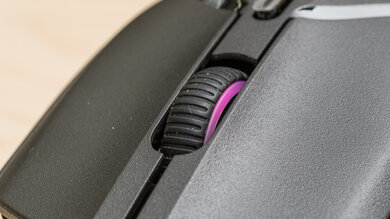The HyperX Pulsefire Haste 2 Wireless is a lightweight wireless gaming mouse that continues HyperX's Pulsefire Haste lineup. Compared to the previous HyperX Pulsefire Haste Wireless, this mouse has an identical shape and weight but no longer has honeycomb cutouts on its body. It also introduces improvements under the hood, including a new sensor and more durable left- and right-click switches.
Our Verdict
Although not designed specifically for this use, the HyperX Pulsefire Haste 2 Wireless is decent for office work. It has excellent build quality and a comfortable symmetrical shape suitable for most hand sizes. You can connect this mouse with a USB receiver or via Bluetooth, and although it doesn't have many buttons, you can program all of them using the customization software. Unfortunately, the scroll wheel lacks L/R tilt buttons and a free-scrolling mode.
-
Excellent build quality.
-
Comfortable symmetrical shape.
-
Scroll wheel lacks tilt inputs and a free-scrolling mode.
-
Few programmable buttons.
The HyperX Pulsefire Haste 2 Wireless is excellent for FPS gaming. It's very lightweight, has excellent build quality, and has a comfortable symmetrical shape suitable for all grip types and most hand sizes. It also delivers outstanding sensor performance and good click latency. However, the click latency isn't as low as many similar wireless gaming mice around this price point. While it's still very well-suited for casual FPS gaming, it isn't well-suited for playing at the highest competitive levels.
-
Good click latency.
-
Extremely lightweight.
-
Excellent build quality.
-
Comfortable symmetrical shape.
-
Click latency isn't as low as many competing wireless gaming mice around the same price point.
The HyperX Pulsefire Haste 2 Wireless is decent for MMO gaming but has fewer side buttons than a dedicated MMO gaming mouse. It has excellent build quality, and you can reprogram all buttons using the customization software. It also has good click latency and outstanding overall sensor performance, delivering a responsive-feeling experience in-game.
-
Good click latency.
-
Excellent build quality.
-
Comfortable symmetrical shape.
-
Not nearly as many side buttons as a dedicated MMO gaming mouse.
The HyperX Pulsefire Haste 2 Wireless has excellent performance overall. Its sensor provides remarkably consistent movement latency and accuracy that closely translates your physical mouse movements with those you see on-screen. It also has good click latency. However, the click latency isn't as low as many other wireless options around this price point and is too high for competitive gaming.
-
Good click latency.
-
Outstanding sensor performance.
-
Click latency isn't as low as many competing wireless gaming mice around the same price point.
- 7.2 Work
- 8.5 Video Games (FPS)
- 7.4 Video Games (MMO)
- 8.8 Raw Performance
Changelog
- Updated Jan 05, 2024: We've updated the CPI graph displayed in the Sensor Latency section of this review. Our results remain the same, but these graphs have two new columns with results from the Delay At Half Movement and Delay To End Of Movement tests.
- Updated Nov 10, 2023: We've retested this mouse on firmware 1.1.0.9 and found that the sensor latency was worse, but click latency was slightly better.
- Updated Oct 02, 2023: We've added text to this review for the new tests added in TBU 1.5.
- Updated Oct 02, 2023: We've converted this review to Test Bench 1.5. This update adds a new Main Button test group, which provides button actuation data and switch information. We've also made minor changes to how we calculate the Office usage score. For more details, you can see our full changelog here.
- Updated May 25, 2023: Review published.
Check Price
Differences Between Sizes And Variants
The HyperX Pulsefire Haste 2 Wireless is available in a black or white colorway. We purchased the black color option, and you can see the label for our unit here.
There's also a wired version of this mouse available, the HyperX Pulsefire Haste 2.
Compared To Other Mice
The HyperX Pulsefire Haste 2 Wireless is a lightweight wired gaming mouse that continues the HyperX Pulsefire Haste lineup. This new version weighs the same as the last generation HyperX Pulsefire Haste Wireless but no longer has any visible honeycomb cutouts in its body. It also has a more accurate and consistent sensor and more durable left- and right-click buttons. This mouse is a more affordable alternative that's just as lightweight as some of the most popular wireless gaming flagships, including the Logitech G PRO X SUPERLIGHT or the Razer Viper V2 Pro. Although, it doesn't quite deliver the same high-end click latency performance as these more premium options, so it isn't as well-suited to fast-paced competitive gaming.
For more recommendations, see our picks for the best mouse, the best gaming mouse, and the best wireless gaming mouse.
The HyperX Pulsefire Haste 2 Wireless and the HyperX Pulsefire Haste 2 are lightweight gaming mice in the same lineup. The Haste 2 Wireless is a wireless model you can connect with a USB receiver or via Bluetooth. On the other hand, the Haste 2 is a wired-only model that's a bit lighter. It also has significantly lower click latency and sensor latency and supports a higher maximum polling rate of 8000Hz, making it better suited for competitive gaming.
The Logitech G PRO X SUPERLIGHT and the HyperX Pulsefire Haste 2 Wireless are wireless gaming mice with symmetrical shapes, and they weigh virtually the same. The Logitech has better build quality and higher-quality feet. It also has significantly better click latency and marginally better sensor latency, making it better for competitive gaming overall. On the other hand, the HyperX has a longer advertised battery life.
The HyperX Pulsefire Haste 2 Wireless and the HyperX Pulsefire Haste Wireless are lightweight gaming mice in the same lineup. The Haste 2 Wireless is newer, and while it weighs virtually the same as its older counterpart, it has a solid plastic shell without visible honeycomb cutouts on its body. It also has better sensor performance and more durable left- and right-click switches. On the other hand, the original Pulsefire Haste Wireless is older and has honeycomb cutouts in its body.
The Razer Viper V2 Pro and the HyperX Pulsefire Haste 2 Wireless are wireless gaming mice with symmetrical shapes. The Razer weighs marginally less and has better build quality. It also has higher-quality mouse feet. It also has significantly lower click latency and better sensor performance, making it the option that's better suited for competitive gaming. On the other hand, the HyperX has a slightly longer advertised battery life and has a compartment for storing its USB receiver, a feature the Razer lacks.
Test Results
The style of this mouse is very similar to the previous HyperX Pulsefire Haste Wireless, but it now has a solid plastic body without visible honeycomb cutouts. A small section of the body still has honeycomb cutouts, but it's on the bottom of the mouse and is covered by its label. The body is made of matte black plastic with a slightly textured finish, while the CPI button and side buttons are glossy. The scroll wheel has a single RGB lighting zone, and there's a HyperX logo on the front left side.
This mouse shares the same shape and dimensions as the previous-generation HyperX Pulsefire Haste Wireless.
This mouse has good portability overall. While the mouse is fairly large and bulky compared to dedicated mice designed specifically for travel or portability, there's a storage compartment for its USB receiver under the mouse so it doesn't get lost in transit.
This mouse has excellent build quality. The plastic feels high-quality and has a slightly rough textured finish. There are no loose or rattling parts and only minimal flexibility if you apply pressure to the body. That said, you can activate the CPI button if you press hard enough into the body next to the CPI button or underneath the mouse. This issue is also present on the wired version of this mouse, the HyperX Pulsefire Haste 2. However, it's important to note this doesn't create any problems and isn't noticeable when using the mouse normally.
Nearly all of the mouse body is made of solid plastic, but weight-saving honeycomb cutouts are hidden under the mouse's label on the bottom.
This mouse is extremely lightweight, and despite now having a solid plastic shell without honeycomb cutouts, it weighs the same as its predecessor, the HyperX Pulsefire Haste Wireless.
The HyperX Pulsefire Haste 2 Wireless has a symmetrical shape with a gradual, slightly flattened hump in the middle and a full, rounded back. It's a comfortable fit for all grip types and most hand sizes, but if you have smaller hands, you won't reach all the buttons using a fingertip grip.
HyperX advertises a maximum battery life of up to 100 hours. While it isn't mentioned explicitly on the product page for this mouse, we expect this to be the maximum battery life for continuous use while connected via its USB receiver with a polling rate setting of 1000Hz, and with RGB lighting turned off.
It's common for manufacturers to indicate a separate maximum battery life for the mouse connected via Bluetooth, which consumes less power than a USB receiver connection. However, HyperX hasn't listed this separate value on its product page. If you have this mouse and would like to share your experience with its battery life, feel free to reach out to us in the Discussions.
This mouse has an excellent charging cable. It's lightweight and flexible and glides smoothly across desks and mousepads. That said, it does retain some kinks from how it's packaged.
This mouse has superb feet with rounded edges that glide well on mousepads with minimal resistance. They make a bit more of a scratching sound on mousepads and directly on desks than the wired version of this mouse, the HyperX Pulsefire Haste 2—but this doesn't affect the gliding experience.
This mouse's left- and right-click buttons use proprietary HyperX mechanical switches. Compared to the TTC gold switches on the previous HyperX Pulsefire Haste Wireless, these switches feel slightly heavier and have marginally more pre-travel.
You can program all of the buttons on the HyperX Pulsefire Haste 2 Wireless, but you can't reprogram the scroll up/down inputs, and the left- and right-click button functions can only be switched.
The HyperX Pulsefire Haste 2 Wireless has good click latency, providing a responsive-feeling gaming experience for casual gaming in all genres. However, you may notice marginal delays affecting your performance in fast-paced, reaction-dependent titles like rhythm or competitive FPS games.
This mouse has exceptional CPI performance. Its sensor delivers outstanding tracking accuracy, and the physical movements you make with your mouse translate extremely close to your cursor movements on-screen.
This mouse has decent sensor latency. There's considerably more delay at the start, mid-way point, and end of movements compared to the wired HyperX Pulsefire Haste 2 as well as the previous generation HyperX Pulsefire Haste Wireless. We expect this may be the result of aggressive battery-saving techniques as the mouse seems to enter a 'sleep' mode much quicker than other mice we've tested and can't be disabled. These latency issues only seem to be present when using the mouse wirelessly. Here are are the sensor latency results in wired mode.
You can adjust the lift-off distance using the software and set up to five custom CPI settings. The polling rate options on this mouse are 125Hz, 250Hz, 500Hz, and 1000Hz.
The scroll wheel has a notched rubber surface, and scrolling feels precise with reasonably defined steps. It's also relatively quiet, and the middle click doesn't require too much force to actuate.
The mouse buttons and scroll wheel on this mouse are fairly quiet and unlikely to bother those around you.
This mouse uses HyperX NGenuity, which you can download from the Microsoft Store or from Hyper X's product page here. The software is easy to use and allows you to reassign buttons, record macros, and adjust sensor settings. You can also save custom macros and RGB lighting preferences to the onboard memory.
However, as is the case with software options from other major manufacturers, this software is the source of criticism from the broader community. While we didn't experience any issues during the testing of this mouse, many users online criticize this software for requiring frequent updates and taking up disproportionate system resources, among other complaints. This software may be frustrating if you prefer more lightweight software options or no software at all.
Comments
HyperX Pulsefire Haste 2 Wireless: Main Discussion
Let us know why you want us to review the product here, or encourage others to vote for this product.
- 21010
The review said it has 2 Maximum Of Paired Devices. Most of other pricier wireless mouse also shows 2. However I couldn’t make it work with 2 different PCs. It connects to both but not “work” on both. There is also no native switch button like logitech ones. Both the box and the manuel never mentions this feature. I think it doesn’t works in multiple devices. Seems like I have to return it and this review should be fixed.
Hello, Thank you for your interest in our reviews. Unfortunately, we no longer have this mouse in stock, so I can’t verify its connection capabilities directly. However, this model supports both Bluetooth and a USB wireless receiver, allowing it to connect to two devices simultaneously, one via the receiver and the other through Bluetooth, without reconfiguration. This test is designed to highlight mice with multiple connection options that make switching between devices easier. For example, you could leave the USB receiver plugged into your desktop or home PC while using Bluetooth to connect to a laptop for on-the-go use.
- 21010
The review said it has 2 Maximum Of Paired Devices. Most of other pricier wireless mouse also shows 2. However I couldn’t make it work with 2 different PCs. It connects to both but not “work” on both. There is also no native switch button like logitech ones. Both the box and the manuel never mentions this feature. I think it doesn’t works in multiple devices. Seems like I have to return it and this review should be fixed.
- 21010
Could it be that you tested the Wireless Version “only” wireless? If I use the wireless model with a cable, are the disadvantages of the wireless model also present? I only use cabled mice at my desk - but I still need a wireless model that I can occasionally use at the living room table. Therefore, for me - and probably for many others with wireless models - the performance with the included cable is always very important. Probably even more important.
Hey redlabour! As you can see when it came to click latency, both wired and wireless connections performed similarly. However the difference is definitely in the sensor latency. One of the big reasons here from what we noticed is the aggressive “battery saving” techniques its using. In wired mode you should expect it to perform better since it will not be utilizing the “battery saving” in this connection.
Hope this helps! thank you for reaching out!
- 21010
Could it be that you tested the Wireless Version “only” wireless?
If I use the wireless model with a cable, are the disadvantages of the wireless model also present?
I only use cabled mice at my desk - but I still need a wireless model that I can occasionally use at the living room table. Therefore, for me - and probably for many others with wireless models - the performance with the included cable is always very important. Probably even more important.
Update: We’ve updated the CPI graph displayed in the Sensor Latency section of this review. Our results remain the same, but these graphs have two new columns with results from the Delay At Half Movement and Delay To End Of Movement tests.
































